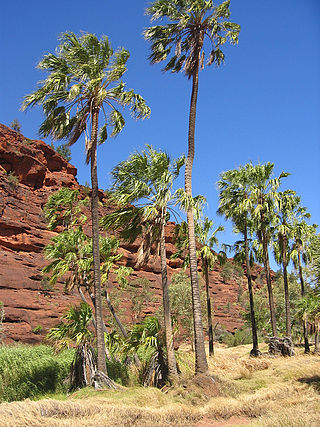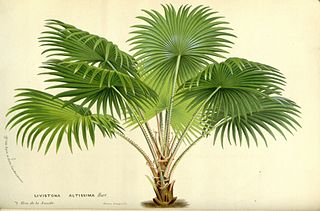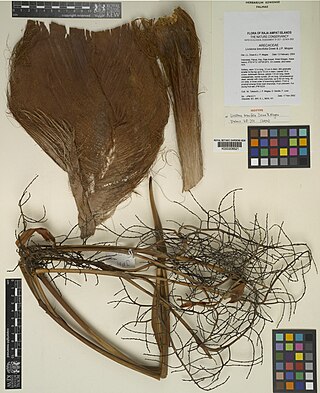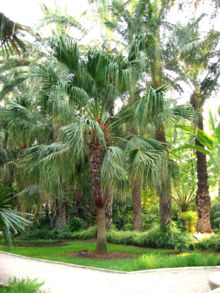
Areca is a genus of 51 species of palms in the family Arecaceae, found in humid tropical forests from the islands of the Philippines, Malaysia and India, across Southeast Asia to Melanesia. The generic name Areca is derived from a name used locally on the Malabar Coast of India.

Calamus is a genus of flowering plants in the palm family Arecaceae that are among several genera known as rattan palms. There are an estimated 400 species in this genus, all native to tropical and subtropical Asia, Africa, and Australia.

Licuala is a genus of palms, in the tribe Trachycarpeae, commonly found in tropical forests of southern China, Southeast Asia, the Himalayas, New Guinea and the western Pacific Ocean islands.

Linospadix is a genus of flowering plant in the family Arecaceae. It is native to New Guinea and Australia.
Livistona endauensis is a species of palm tree of the genus Livistona. It is a tree endemic to Peninsular Malaysia. It has been called Endau fan palm in English. In Malay the palm is known as bertam or serdang Endau.

Livistona mariae, also known as the central Australian or red cabbage palm, is a species of flowering plant in the family Arecaceae.
Physokentia is a genus of flowering plant in the palm family, native to certain islands of the western Pacific.

Orania is a genus of the palm tree family Arecaceae, whose native is Madagascar, Malesia, and New Guinea.

Hydriastele is a diverse and widespread genus of flowering plant in the palm family found throughout northern Australia, Melanesia, Polynesia, and Southeast Asia. It consisted of just nine species until 2004, when molecular research, supported by morphologic similarities, led taxonomists to include the members of the Gulubia, Gronophyllum, and Siphokentia genera. About 40 species are now recognized.

Rhopalostylidinae is a botanical subtribe consisting of two genera of palms from Australia and New Zealand, Hedyscepe and Rhopalostylis. These two genera were formerly included in Archontophoenicinae, to which they are morphologically similar, until a recent revision.

The Coryphoideae is one of five subfamilies in the palm family, Arecaceae. It contains all of the genera with palmate leaves, excepting Mauritia, Mauritiella and Lepidocaryum, all of subfamily Calamoideae, tribe Lepidocaryeae, subtribe Mauritiinae. However, all Coryphoid palm leaves have induplicate (V-shaped) leaf folds, while Calamoid palms have reduplicate leaf folds. Pinnate leaves do occur in Coryphoideae, in Phoenix, Arenga, Wallichia and bipinnate in Caryota.

Saribus is a genus of palms, native to Southeast Asia, Papuasia and Pacific Islands. They are fan palms, the leaves with an armed petiole terminating in a rounded, costapalmate fan of numerous leaflets.
Clinosperma is a palm tree genus in the family Arecaceae.

Saribus woodfordii is a species of fan palm which is native to an area from southeastern Papua New Guinea to the Solomon Islands.

Trachycarpeae is a tribe of palms in subfamily Coryphoideae of the plant family Arecaceae. It has the widest distribution of any tribe in Coryphoideae and is found on all continents, though the greatest concentration of species is in Southeast Asia. Trachycarpeae includes palms from both tropical and subtropical zones; the northernmost naturally-occurring palm is a member of this tribe. Several genera can be found in cultivation in temperate areas, for example species of Trachycarpus, Chamaerops, Rhapidophyllum and Washingtonia.
Natalie Whitford Uhl (1919–2017) was an American botanist who specialised in palms.

Livistona jenkinsiana is a species of fan palm in the family Arecaceae.
Saribus chocolatinus is a species of palm tree in the genus Saribus, which is native to Papua New Guinea. It is a fan palm.

Saribus brevifolius is a species of palm tree in the genus Saribus, which has only been found in the Kawe and Gag Islands in the archipelago of the Raja Ampat Islands, which lie off the north-west tip of the Bird's Head Peninsula in Indonesia's West Papua province. It was only discovered in 2002 during an expedition funded by The Nature Conservancy. The palm grows along the coasts of these two tropical islands on small ridges composed of ultrabasic rock. It is a moderately-sized fan palm with smallish and regularly segmented leaves and a smallish inflorescence in the crown. The inflorescence is not longer than the leaves, and split at its base into three main branches with one or more sub-inflorescences, these containing red flowers with pink anthers. The ends of S. brevifolius leaf segments are rigid and have a bifurcate cleft 1-4% of the segment length.

















